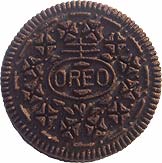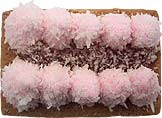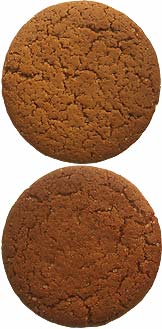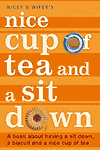Oreo | | Saturday 22 Feb 2003 |

 | Oh dear, oh dear, oh dear. I didn't mean to review the Oreo this week, it just sort of happend, due to my intended biscuit not being on the shelves in Sainbury's. So lets take a look at what the great all American biscuit, (naturally it thinks its a cookie) can offer the rest of the free world.
Baked by Nabisco, (National Biscuit Company) since its founding in 1898, and currently selling at the rate of 11 billion biscuits a year, the Oreo proudly proclaims itself the world's number 1 biscuit. Nowadays Nabisco is part of Kraft foods which is part of the Philip Morris group of companies (recently renamed to Altria Group), who own most brands of cigarettes, coffee, chocolate and snack foods you can think of. Marlboro, Benson & Hedges, Maxwell House, Dairylea, Milka, Terry's, Kenco, Planters, Vegemite and Ritz, to name just a very very few. Altria are also the largest shareholder in world's second-largest brewer, SABMiller. Nabisco bakes the Oreo world wide, our review pack being baked in Spain. The Oreo is basically an imperial juggernaut of a biscuit, whose stable mate brands use nicotine, alcohol, caffeine, fat and sugar to appeal to consumers. If you are looking for that lovingly home baked taste you really have come to the wrong place.
So what can we say about the Oreo as a biscuit other than its capitalist credentials? Well its main ingredient is sugar and it consists of two rather sickly dark cocoa biscuits, bearing the company logo, back to back with some white sugary creme stuff in between. Variants are available where the creme is flavoured with coffee, mint etc. There are also ones that have been covered in fudge of various types. Can you feel your arteries hardening as you read this?
The pack absurdly comes with eating instructions, of which there are six stages. I won't detail them all but basically you are encouraged to wrench the thing into its component parts. What is the point of assembling it in the first place if you have to take it all to bits to eat it? Well I'm assuming this is what Altria refers to as "Marketing Excellence: Expertise and imagination applied by our consumer packaged goods companies in the development of outstanding consumer brands." This statement is number two on the list of what Atria stands for. As an un-initiated limey I would call it something a lot more colourful and Anglo Saxon.
I'm also gratified to see that the pack describes the contents as biscuits not cookies, maybe because its a localised Euro pack, but then again they are made by Nabisco not Nacooco. The Oreo website actually has quite a lot of facts and figures, which we are keen on. The problem is that none of them actually made sense or corresponded to each other. The figure of 49 billion Oreos does indeed get you to the moon and 6 times if you stack them on end. However, if they sell 11 billion a year and they have sold 49 billion in total then they must be enjoying phenomenal growth. They also mention that they have sold 4.9 billion on average every year. Well as we have seen they are over 100 years old, so I make that getting on for 5 trillion Oreos.
So to wrap up, if you want to make a protest against globalisation through the medium of biscuits then the Oreo is the chappy. Simply stand in front of them in your supermarket and prevent other shoppers from picking them up. Your feedback 24 messages |
| Jacob's Mikado | | Wednesday 12 Feb 2003 |
 | This biscuit review very nearly didn't happen. As you may know, the Wife went on a mission to Ireland to retrieve the Mikado, and on the way back we suspect they took an unplanned trip via Innsbruck Austria. They finally arrived the next day couriered up from the airport. As we have mentioned before Jacobs operate two bakeries, one in Liverpool and the other across the Irish sea in Dublin. Despite our Mikados being bought in Ireland it was not possible to tell which side of the water they were baked.
Now there has already been some debate about Mikados and the oddity that there are two sorts of Mikado, a tall straw like affair and the marshmallow variety seen here. Whilst in France I glimpsed the tall variety in a supermarket but alas was unable to secure a packet. However, this sighting in the wild shows that there is still a bakery someplace knocking them out.
Now to the biscuit at hand. The Mikado is classically associated with children's birthday parties, where it provides a staple source of marshmallow and jam. I always have reservations about the use of coconut in biscuits which seems more of a nod towards dietary fiber content rather than flavour, however, in the Mikado the tartness of the simulated raspberry jam (its actually apple), keeps the coconut at bay. The biscuit base is quite soft, with a crunch nowhere to be found. It does manage to sport some grid like biscuit graphics, so it does appear to have some sort of mechanical properties. The pink marshmallow is arranged in two rows, five blobs in each. The jam provides us with a mystery which is quite difficult to see in our picture, but biscuit carries three blobs but arranged in a four blob central row with the second blob missing. Did our biscuits come from a faulty batch? Is this a cost cutting measure or is this deliberate?
So what is the overall effect of all of this tea time treat technology? Well its possibly the closest thing in the biscuit world to a salad. Having said that the younger members of staff destroyed their ration of review biscuits at an impressive rate and even asked nicely for more, so it appears that the Mikado has lost none of its party time magic.
Edit: Previously the Wife thought the Mikado was called a 'Kimberly Mikado', due to her memory of an Irish TV advert. In fact they are two different biscuits both members of the flagship trilogy of biscuits created by Jacob's, 'The Kimberly', 'The Mikado' and 'The Coconut Cream', all imortalised by the jingle in the advertisement shown on Irish television during the eighties "Kimberly, Mikado and Coconut Cream, someone you love, would love some Mum!". Thanks to James Thomas and others who put us right on this. Your feedback 7 messages |
| Griffin's vs McVities Ginger Nut | | Sunday 26 Jan 2003 |
 | This week we have again pitched the Northern Hemisphere against the Southern again involving a biscuit he have previously reviewed, this time way back in November 2001, the McVities Gingernut vs from New Zealand the Griffins Ginger Nut.
When we reviewed the Griffins chocolate chip cookies last year we were very impressed at their hardness, so it was with some trepidation that we approached their Gingernuts. Indeed during the review I've had to have dental work done for the first time in three years due an inlay filling suddenly working loose.
Both biscuits are pictured alongside with the McVities at the bottom. Although both biscuits are almost identical in size, which is oddly comforting, they do differ in colour somewhat. The McVities is noticeably darker brown, which is most probably due to the inclusion of molasses as opposed to Griffins use of brown sugar in their recipe. The pattern of cracks on top of the biscuits is also distinct and different, with the McVities displaying a little calm zone in the center and the Griffins having a more homogenous distribution.
Now the serious business of biting in. The McVites offers a nice hard biscuit which soon yields to give a pleasant munchy mouthful. The Griffins presents much more of a challenge. Yes we were not disappointed, the Kiwi biccy displayed enormous levels of durability. In fact if these were indeed nuts I would rate the McVites as a Pecan with the Giffins as a Brazil and a control Digestive as say a peanut shell. When the Griffins finally does succumb it offers a very satisfying munch, with the interior of the biscuit possibly not quite as hard as its outer surface.
As for flavour, well once again the molasses in the McVites play their part, as does the inclusion of some lemon oil. Overall the McVities has a rich sweetness with spicy fragrant notes from the ginger. The Griffins on the other hand has slightly simpler appeal with the Ginger playing an almost peppery flavour over the top of its less complex sweetness. Comparing the two is like putting a good Single Malt up against a fine blended Whiskey, maybe.
Once again our thanks to Fraser of Blogjam for providing the Kiwi biccies. Your feedback 2 messages |
| |
|
|







